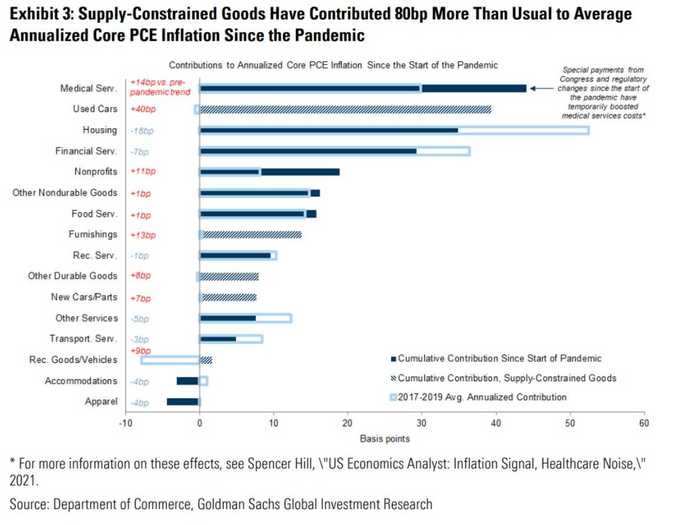Shoppers browse in a supermarket while wearing masks to help slow the spread of coronavirus disease (COVID-19) in north St. Louis, Missouri.Lawrence Bryant/Reuters - Headline inflation is soaring, but other data points suggest price growth will soon cool.
- Shortages and year-over-year comparisons have contributed to elevated inflation readings, Goldman Sachs said.
- Presented below are three charts detailing why inflation isn't as strong as main gauges make it seem.
The specter of inflation might not be as scary as many anticipated.
Gauges of nationwide price growth show inflation hitting its fastest rate since 2008 as the economy reopens and businesses struggle with supply shortages. Yet underlying dynamics aren't so clear-cut, economists at Goldman Sachs said in a Wednesday note.
For one, much of the overshoot seen in recent months is linked to production bottlenecks. Used car prices, for example, have surged more than any other category as the global semiconductor shortage curbs vehicle manufacturing.
The unusual nature of the pandemic economy also makes measuring inflation more difficult. With the country still reopening, spending is quickly shifting from goods to services.
It's likely that, after accounting for some pandemic-related trends, inflation is weaker than headline gauges suggest, economists led by Jan Hatzius said. Here are three charts revealing how inflation is a smaller danger than experts feared.
1. Inflation just isn't that high
Goldman Sachs
Present-day inflation readings are still skewed by last year's data. Price growth is typically tracked on a one-year basis. Since prices declined at the start of the pandemic and only grew slightly through spring 2020, the year-over-year comparison has skewed inflation readings higher.
In reality, prices are only "rebounding from low levels," the team said.
A simple calculation reveals inflation is far closer to normal levels than it initially appears. Core Personal Consumption Expenditures — a popular inflation gauge that excludes volatile food and energy prices — is up 3.4% from the year-ago level. But on an average annualized basis, the measure is up just 2.4%.
And in categories where prices plummeted the most, the difference between year-over-year and average annualized readings show an even larger disparity. Hotel inflation is down 4.3% on an annualized basis, but up 9.8% year-over-year. Annualized inflation for apparel is down 3.1%, but up 6% from the year-ago reading.
2. Shortages present a temporary hurdle
Goldman Sachs
The broad consensus maintains that the stronger inflation seen through spring will be temporary and fade as bottlenecks are solved. Data compiled by Goldman supports that outlook.
Production slowdowns, material shortages, and shipping delays have all curbed businesses' abilities to service demand. The effects are most powerful in goods sectors. Used car prices — which led inflation gauges higher in April and May — have risen at an annualized rate of 27.4%, but their pre-pandemic average was a 1.3% contraction.
Similar gaps can be seen in the furnishings, recreational goods and vehicles, and other durable goods sectors. Those disparities suggest that, as shortages are addressed, price growth will quickly revert back to healthier levels.
3. Supply problems are having a larger-than-usual impact
Goldman Sachs
The nationwide shortages are also boosting headline inflation more than usual. Supply-constrained goods contributed more than 0.8 percentage point to average annualized core PCE inflation, Goldman said. Put another way, those strained sectors have been the driving force behind stronger-than-average price growth.
Used cars count for half of that contribution, with a 0.4 point boost to core inflation. Bottlenecks in household furnishings and recreational goods each added 0.1 points to the headline metric.
Had supply-constrained sectors been operating at their pre-pandemic rates, inflation would average about 1.6% through the pandemic, the economists said.
"Looking ahead, we think that inflation in these categories is likely to slow, undershooting their normal inflation rate as supply-demand imbalances resolve and prices levels partially return to trend," the team added.



